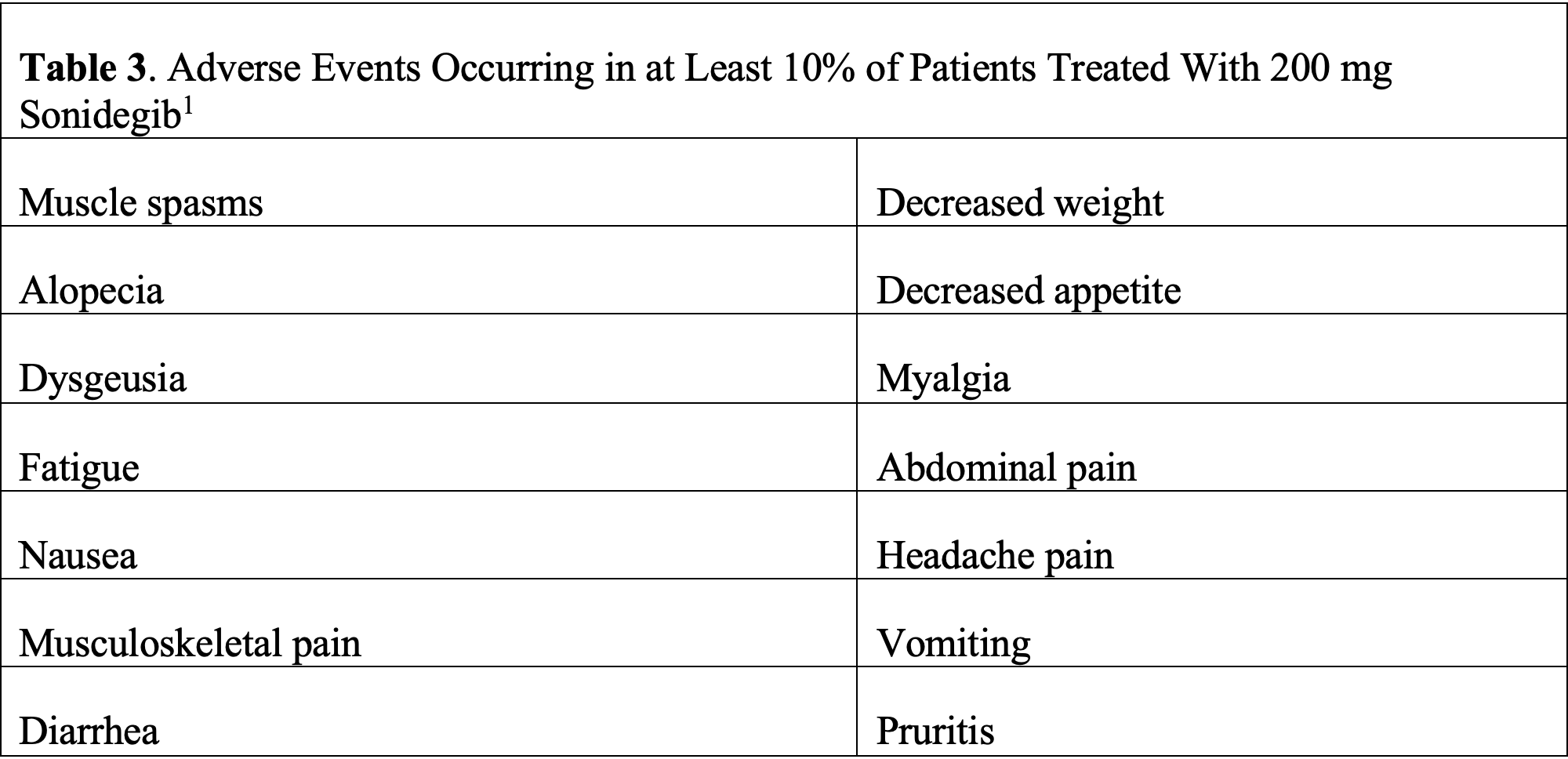Article
Sonidegib, a Hedgehog Signaling Pathway Inhibitor for Locally Advanced Basal Cell Carcinoma
Author(s):
Sonidegib binds to and inhibits a transmembrane protein to disrupt hedgehog pathway signal transduction and leading to antitumor activity in patients with locally advanced basal cell carcinoma.
Sonidegib (Odomzo, Sun Pharma) is a hedgehog signaling pathway inhibitor indicated for the treatment of adults with locally advanced basal cell carcinoma (laBCC) that has recurred despite surgery or radiation therapy, or in those who are not candidates for surgery or radiation therapy.1
Mutations in hedgehog signaling pathways are present in up to 95% of BCC cases.2 While most BCCs respond to topical therapy, surgery, and/or radiotherapy, laBCC remains difficult to treat: pharmacologic options are limited and represent an ongoing challenge for clinicians.2
Approved by the FDA in 2015, sonidegib is a newer choice for the treatment of this patient population.
Mechanism of Action
Sonidegib binds to and inhibits a transmembrane protein known as Smoothened, disrupting hedgehog pathway signal transduction and leading to antitumor activity.2
Dosage
Prior to initiating sonidegib in a female of reproductive potential, clinicians must verify her pregnancy status. Sonidegib is embryotoxic, fetotoxic, and teratogenic in animals due to its antiproliferative effects.1
The recommended dose of sonidegib is 200 mg by mouth once daily on an empty stomach.1 Clinicians should advise patients to take this medication at least 1 hour before or 2 hours after a meal.1
Patients may take sonidegib until disease progression or unacceptable toxicity.1 Patients should permanently discontinue sonidegib in the presence of:1
- Serum creatine kinase (CK) elevations greater than 2.5 times the upper limit of normal (ULN) with worsening renal function.
- Serum CK elevations greater than 10 times the ULN.
- Recurrent serum CK elevation greater than 5 times ULN.
- Recurrent severe or intolerable musculoskeletal adverse reactions.
Sonidegib’s prescribing information provides additional guidance on interrupting therapy in the presence of other aberrations in CK and musculoskeletal adverse reactions.1
FDA Approval
Data from the randomized, double-blind, multiple-cohort, phase 2 BOLT study led to sonidegib’s approval after promising phase 1 results.1-3 There was no active comparator drug available at the time of trial initiation.2
Instead, patients in the study received either 200 mg or 800 mg of sonidegib, assigned via randomization.1 A total of 230 patients enrolled in BOLT. The study resulted in an objective response rate (ORR) of 58% in patients with laBCC enrolled in the 200 mg group and 44% in the 800 mg group.2,4
The study authors used the mRECIST criteria to assess ORR (Table 1 and 2).5


Although both doses studied in BOLT demonstrated efficacy, 200 mg of sonidegib provided a more favorable adverse effect (AE) profile, with a lower frequency of AE incidences compared to the higher dose of 800 mg.2 The most common AEs leading to discontinuation of treatment were muscle spasms, dysgeusia, weight decrease, and nausea.2
Contraindications, Warnings, and Precautions
Sonidegib can cause embryo-fetal death or severe birth defects when administered to a pregnant woman. Females should use effective contraception during treatment and for at least 20 months after the last dose.1 Males with female partners should use condoms, even after a vasectomy, during treatment and for at least 8 months after the last dose of sonidegib.1
Sonidegib may cause musculoskeletal AEs, with or without elevations in serum CK. Clinicians should obtain baseline serum CK and creatinine levels prior to treatment initiation, periodically during treatment, and as clinically indicated (i.e., if muscle symptoms are reported).1 Temporary dose interruption or permanent discontinuation may be warranted. Consult the prescribing information for further guidance.1
Patients taking sonidegib should avoid concomitant administration with both strong and moderate CYP3A inhibitors and inducers.1
AEs
The most common AEs noted in the BOLT trial are indicated in table 3.1

Special Populations
Clinicians should avoid use of sonidegib in pregnant women and report new pregnancies to Sun Pharmaceutical Industries, Inc, at 800-406-7984.1 Women should not breastfeed while on sonidegib and for at least 20 months after discontinuing the medication.1
No safety or efficacy trials exist for sonidegib use in children. Some pediatric patients exposed to sonidegib have developed epiphyseal disorders. Advise patients to keep sonidegib out of the reach of children.1
About the Author
Lisa Ruohoniemi, PharmD, is a clinical staff pharmacist at LewisGale Hospital Montgomery in Blacksburg, Virginia.
References
1. Odomzo. Prescribing information. Sun Pharma; 2015. Accessed June 6, 2022. https://www.odomzo.com/themes/custom/odomzo/global/pdfs/pi.pdf
2. Migden MR, Guminski A, Gutzmer R, et al. Treatment with two different doses of sonidegib in patients with locally advanced or metastatic basal cell carcinoma (BOLT): a multicentre, randomised, double-blind phase 2 trial. Lancet Oncol. 2015;16(6):716-728. doi:10.1016/S1470-2045(15)70100-2
3. Rodon J, Tawbi HA, Thomas AL, et al. A phase I, multicenter, open-label, first-in-human, dose-escalation study of the oral smoothened inhibitor Sonidegib (LDE225) in patients with advanced solid tumors. Clin Cancer Res. 2014;20(7):1900-1909. doi:10.1158/1078-0432.CCR-13-1710
4. Casey D, Demko S, Shord S, et al. FDA Approval Summary: Sonidegib for Locally Advanced Basal Cell Carcinoma. Clin Cancer Res. 2017;23(10):2377-2381. doi:10.1158/1078-0432.CCR-16-2051
5. mRECIST. Sun Pharma. Accessed June 6, 2022. https://www.odomzo.com/hcp/mrecist






